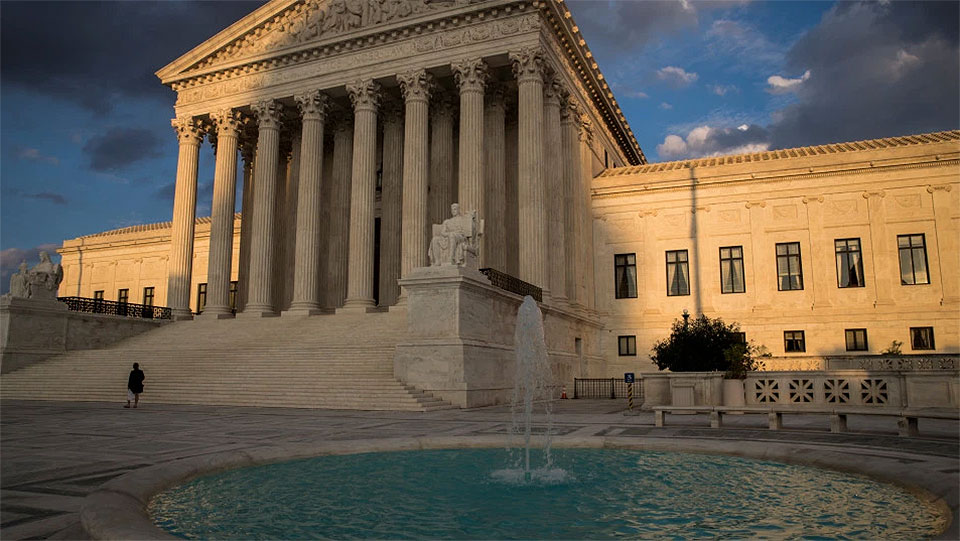
WASHINGTON—Disappointing citizens, workers, and clean-government advocates, the U.S. Supreme Court upheld Michigan’s GOP-gerrymandered congressional and state legislative district lines.
But the justices’ one-paragraph order on Oct. 2 will cover just the 2020 election.
After that, a non-partisan 13-voter commission will take over the task of drawing new districts, thanks to an overwhelming vote in last November’s election for establishing the panel of four Democrats, four Republicans, and five independents.
The state League of Women Voters (LWV) and other groups, including the Michigan Education Association, led the drive for the non-partisan commission. Their Michigan Redistricting Collaborative also sued in late 2017 to overturn the current legislative maps.
Lower federal courts sided with the collaborative coalition. But the Supreme Court, citing a ruling its own GOP-named five-man majority handed down at the end of June, didn’t. That decision said courts cannot decide whether partisan gerrymandering violates voters’ rights.
The Michigan ruling is important. It means the old gerrymandered legislative lines will stay in effect for next year’s balloting. The heavily Republican 2011 legislature drew those boundaries and the results were a disaster for workers and others.
The justices’ ruling, however, also comes as more states turn to non-partisan commissions to draw legislative lines – a development the justices acknowledged in June. In 2018, Ohio voters also OKd a non-partisan commission starting in 2021, but only for state legislative lines. California, Arizona, and Iowa already have non-partisan panels – and workers and voters benefit.
Michigan’s lines entrenched GOP right-wingers and business into legislative control in the state capital of Lansing. The lines also packed most of Michigan’s Democratic voters, in a classic “swing state,” into a handful of congressional and state legislative districts – or split minorities and Democrats between adjoining districts, eliminating their power to influence elections.
“Michigan’s State House, Senate and congressional districts are among the worst in the nation when it comes to partisan gerrymandering, and (the) lawsuit aims to fix the problem and restore voters’ rights to choose who best represents them,” said Michigan LWV President Judy Karandjeff when the coalition sued in 2017. “For too long, Michigan voters’ rights have been harmed as a result of partisan gerrymandering.”
The anti-worker Republican majorities emasculated worker protections, including converting Michigan into a so-called “right to work” state. They also sharply weakened teacher tenure, reduced jobless benefits and enacted other anti-worker measures. The Michigan Education Association had no immediate comment on the High Court’s pro-gerrymandering ruling, and its 2018 endorsement was a one-paragraph statement.
After the GOP cemented its control, the overwhelmingly white Republican lawmakers also approved a draconian “czar” ordinance. It let the state summarily take over “financially failing” local government bodies and impose its own conditions on them, including eliminating union contracts. Not coincidentally, all the czars have ruled majority-minority cities and school districts.
The state czar in Flint, to save money, ordered the city’s water source switched from clean Lake Huron to the dirty Flint River. Its water was so bad that lead leached from the city’s ancient pipes into the water supply. The czar refused to OK chemicals to get rid of the lead, and tens of thousands of residents, especially children, were poisoned.
While the High Court’s order means the lower courts will also dismiss the anti-gerrymandering lawsuit, the League of Women Voters, which led the fight, looked on the bright side: After 2020, the citizens’ commission, not the lawmakers in Lansing, will draw the lines.
“Voters passed this constitutional amendment in the November 2018 general election, which makes citizens — not legislators or special interests — responsible for drawing district lines,” LWV said.
Michigan’s Secretary of State, whose office runs elections, is already developing an application for the prospective commissioners, along with instructions on when and how to apply.
“This commission will operate in a completely transparent manner and will create maps based on fair criteria,” the league said. “Michigan’s political districts are redrawn every decade following receipt of the new census data This process typically takes place behind closed doors, with districts designed to benefit the political party in power at the time.”
“The way district lines are drawn can keep our communities together or split them apart. Although the legislature is bound by some legal standards, they can also establish and prioritize criteria for drawing districts. In addition to legal criteria, information about voters’ political leanings is used to project which party the district is likely to support. This allows for partisan gerrymandering – drawing lines to cluster voters according to whether they are likely to vote Democratic or Republican – with the goal of securing seats in Congress or the legislature.”
“The lack of citizen involvement and the self-interest of those conducting the process are a risky combination. It allows representatives to choose their voters rather than the other way around.”
With the commission drawing the lines, starting in 2021, that won’t happen anymore, the league said.










